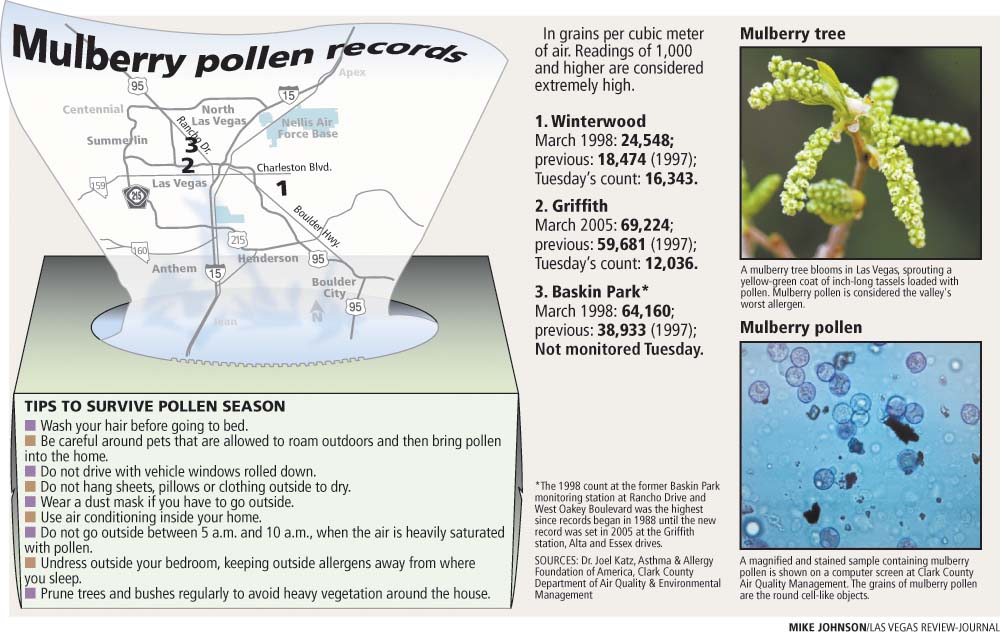Pollen hangs thick in air
It's not a record, but it's certainly something to sneeze at.
Pollen from mulberry trees has been on the rise this month, but it's not close to the record set five years ago or even the previous record season of 1998.
Nevertheless, the 2010 season will go down in the books as a bad one because of its duration and prolonged effects on those who suffer from allergies, said Dr. Joel Katz, a Las Vegas allergist.
"I don't think it's particularly worse but with mulberries we are having slow pollination, a prolonged pollination. It's the duration," he said.
His practice of late has swelled like the eyes of the patients he treats.
In a word, it's been "crazy," Katz said Friday.
"Pollen counts are extremely high and patients are suffering tremendously," he said.
The list of symptoms is not limited to sneezing and headaches.
"People are being seen for severe itching, swelling around the eyes, stuffy runny noses, congestion, sore throats, shortness of breath and wheezing," he said. "Many have hives from the pollen, which is on their cars, benches and all over outside."
Almost everyone with any sensitivity to pollen is affected by very high concentrations of more than 1,000 grains per cubic meter of air. Sensitive people have severe symptoms, according to the Clark County Department of Air Quality and Environmental Management.
On Tuesday, the most recent count by county air quality technicians tallied 16,343 grains per cubic meter of air at the Winterwood monitoring station on Club House Drive near East Sahara Avenue.
For comparison, the Winterwood station recorded 24,548 grains per cubic meter of air on March 22, 1998.
Clark County began monitoring pollen in 1988, and the record mulberry pollen count is 69,224 grains per cubic meter, set in March 2005 at the Griffith station. That station, at Alta and Essex drives, recorded 12,036 grains per cubic meter on Tuesday.
The good news is mulberry pollen has reached its peak for the season and is on the decline, said Mike Sword, the county's air quality engineering manager.
"This year we're pretty sure we missed the high peak day, so the peak is behind us," he said.
At each monitoring station, samples are collected two or three times a week on a pair of toothpick-sized plastic rods that have been coated with silicon grease. The rods, attached to a disc the size of a coffee can lid, pop up periodically and whirl around in the open air.
Technicians spend a couple of days analyzing the samples before posting the results.
"What we've monitored lately shows a little bit lower than it has been," Sword said.
For respiratory therapist Toby Small, a pollen reprieve won't come soon enough.
"I've been sneezing like crazy all day and it doesn't seem like anything can touch it," Small said Friday afternoon at a health care rehabilitation facility where he works in northwest Las Vegas.
He said two allergy medications that contain decongestants haven't put a dent in his pollen problem.
"I'm going to drink lots of water and keep blowing my nose and hope it goes away," Small said.
While over-the-counter antihistamines or a localized mix of plant fungus and pollen from fruited mulberries, European olives, juniper and oleander taken in a liquid form can provide relief to some people, others need the help of allergy experts.
Allergist Katz said patients with severe problems may need a series of desensitization shots. After evaluation through skin tests, an allergen serum is tailored to fit the needs of an individual patient. The mixture is first given at low doses, then increased to build up the patient's immunity.
"This is a long-term control treatment," he said.
This preferred treatment, he said, should not be confused with steroid shots, which are often referred to as allergy shots.
Just one mulberry flower cluster contains as many as 10,000 pollen grains.
A pollen grain is the plant's male sex cell. It fertilizes the plant's pistil or female sex organ. In the case of the fruitless mulberry tree, pollen is delivered to the pistil by the wind.
Years ago the county banned planting of fruited mulberry trees but those that were grandfathered in have grown large canopies over several decades.
Pollen released from other trees such as pine and ash peaks in January or February and lingers into June. Those who suffer from the effects of pollen should brace for what's next, Katz said. "We had the ash pollen and now the mulberry, and olive is going to begin soon," he said.
Contact reporter Keith Rogers at krogers@reviewjournal.com or 702-383-0308.
on the web
For more information
Clark County's pollen report
Local and national allergy forecast:

















